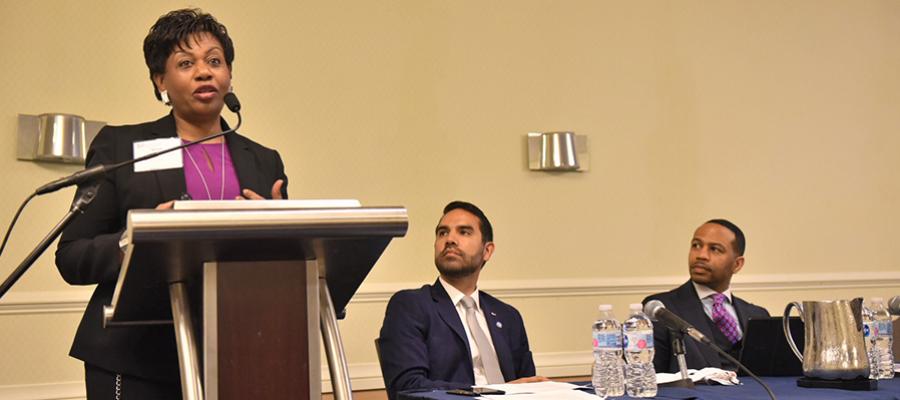Diversity Roundtable Discusses Eliminating Health Disparities

Pictured, from left to right: Tanya Blackmon, executive vice president and chief diversity and inclusion officer, Novant Health; Institute for Diversity and Health Equity Chairman Nicholas Tejeda, market CEO, Hospitals of Providence; and Armond S. Kinsey, chief equity, inclusion and diversity officer, Kaiser Permanente, Mid-Atlantic States.
Institute for Diversity and Health Equity Chairman Nicholas Tejeda, market CEO, Hospitals of Providence, led a special briefing discussion with representatives from the Centers for Medicare & Medicaid Services’ inaugural Health Equity Award winning organizations, Kaiser Permanente and Novant Health, during the recent AHA Annual Membership Meeting.
Tanya Blackmon, executive vice president and chief diversity and inclusion officer, Novant Health, and Armond S. Kinsey, chief equity, inclusion and diversity officer, Kaiser Permanente, Mid-Atlantic States, joined Tejeda to share what their respective organizations are doing to reduce disparities in health care quality and outcomes for the individuals they serve.
When addressing health care disparities it is imperative to begin by creating a climate of change and embedding it within your organization’s culture, the panelists said. Both health systems have advanced this work by ensuring top-down buy-in and accountability. “Health equity, diversity and inclusion must be more than a program, as programs can be picked up and put down when convenient,” said Blackmon.
Furthermore, panelists stressed the idea of partnership, particularly community partnerships, when addressing the social determinants of health. Providing services and education where community members shop, eat, pray or convene can expand the safety net and address gaps in care. It also is critical in fostering trust between health care organizations and the communities they serve, the panelists said. Kaiser Permanente’s Great Hair and Great Health initiative, which sends a mobile health van to conduct health screenings at local barbershops and beauty salons in Baltimore, is just one example of their work to reduce health disparities and help communities across the country. Novant’s web chat forums provide a platform to educate and learn about disparities across the nation, while their leadership retreats always include discussions on diversity and inclusion.
Both organizations also highlighted consistent efforts to educate and train their workforce on health care disparities. “We cannot stress enough to our staff and clinicians that education is the only way we will start closing and eliminating these disparities,” Kinsey said.
At the roundtable, Institute Interim President and CEO Cynthia Washington introduced the Institute’s new mission with a brief video detailing the benefit of Institute membership for AHA hospital and health system members and highlighting AHA’s diversity initiatives and the work of its Equity of Care campaign. Attendees also participated in live-polling questions related diversity and health equity work through their mobile devices.
To learn more and obtain resources to advance health equity, diversity and inclusion in your organization, visit www.diversityconnection.org.

